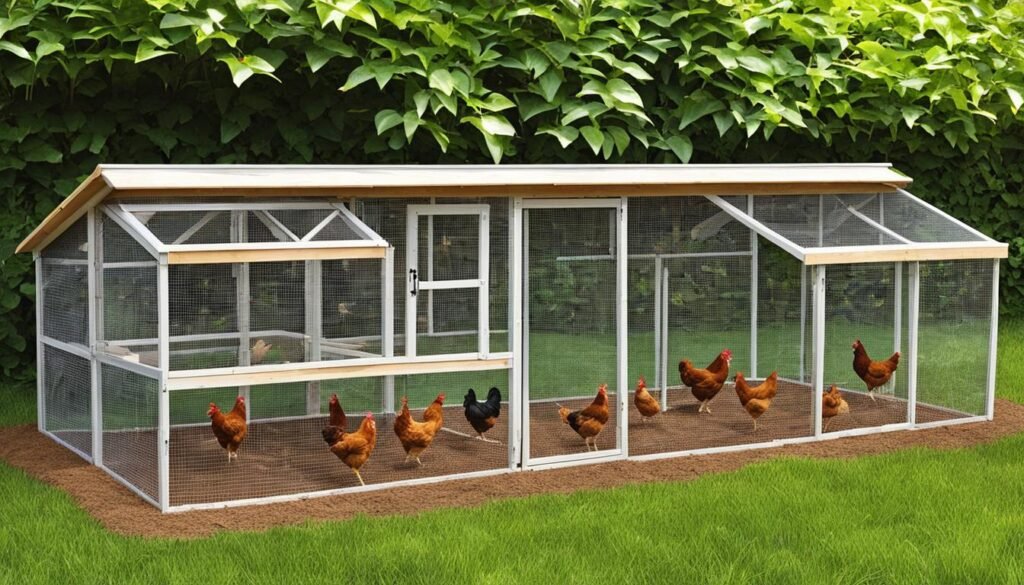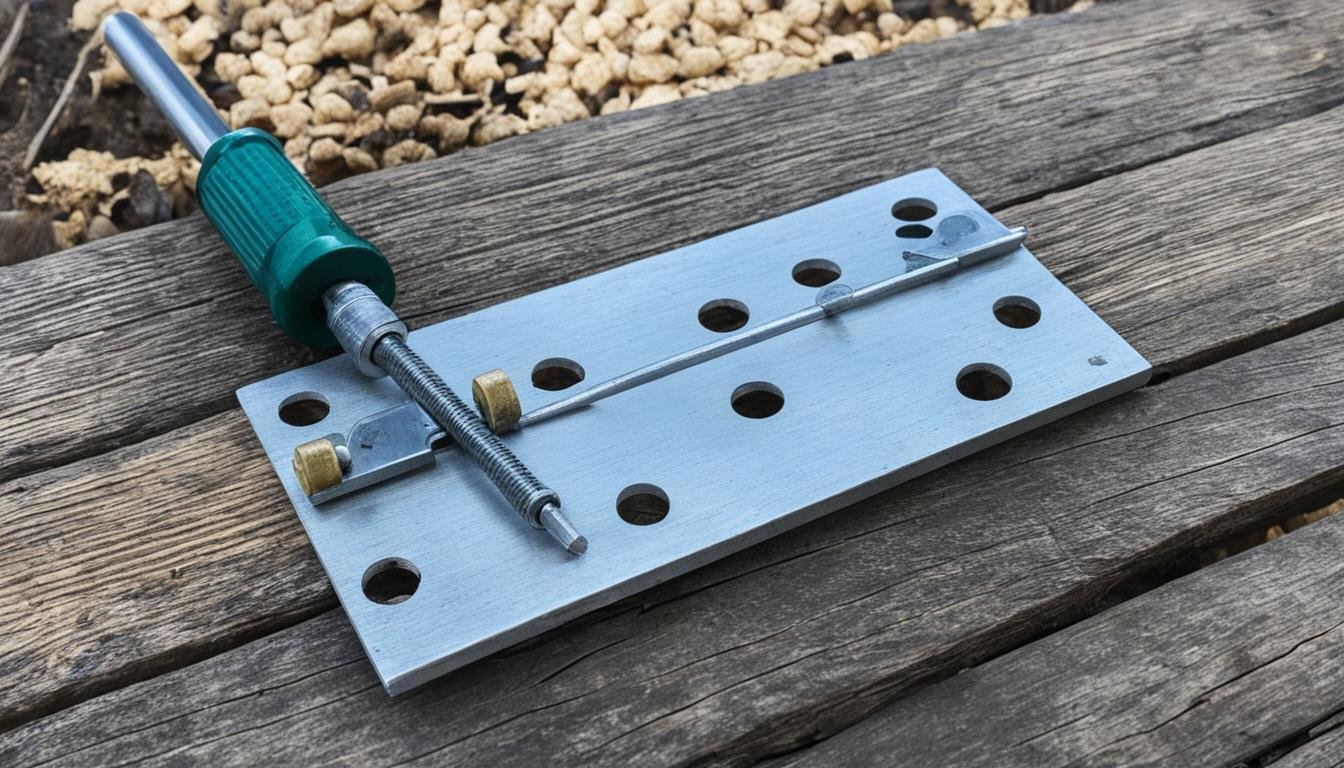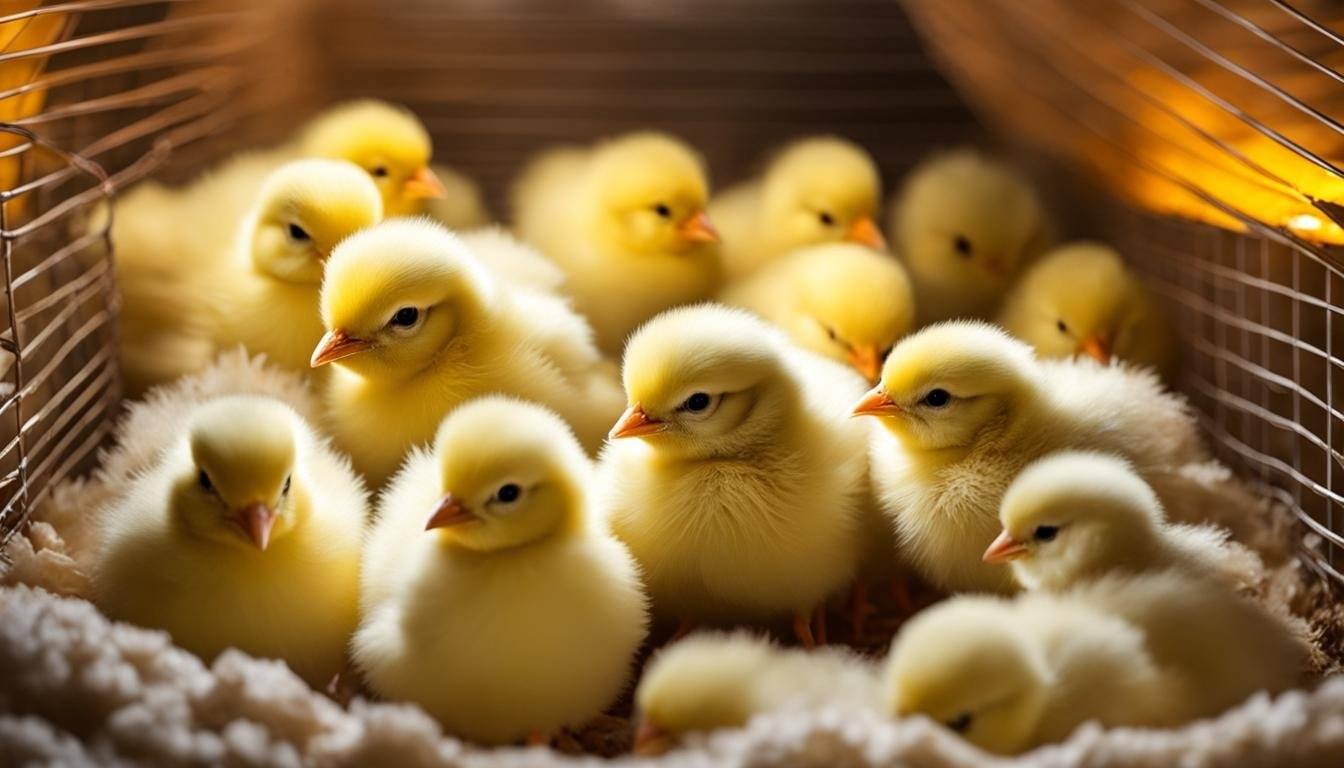Welcome to our comprehensive guide on chicken space requirements! If you’re considering keeping backyard chickens, it’s crucial to understand the importance of providing adequate space for their well-being. In this article, we will discuss the optimal chicken enclosure size, recommended space for raising chickens, and ideal chicken coop dimensions.
Chickens need enough space to lead healthy and happy lives. A properly sized chicken coop and run not only minimize stress and prevent bad behaviors but also promote good health and maintain a clean environment. By allocating appropriate room for poultry, you can ensure that your chickens thrive and flourish.
Factors such as breed, flock size, climate, and available space play a significant role in determining the ideal space for your chickens. Every chicken has unique needs and temperaments, so it’s essential to consider these factors when planning their coop size.
Stay with us to discover the importance of coop size, factors to consider when determining coop size, and guidelines for coop and run size. We will also provide specific guidelines based on flock size and discuss the coop size for bantams. Let’s create an optimal space for your chickens and ensure their happiness and health.
The Importance of Coop Size
When it comes to keeping chickens, the size of their coop plays a vital role in their overall well-being and happiness. Adequate space is essential for minimizing stress, preventing bad behaviors, promoting good health, and maintaining a clean coop environment. It’s not just about providing shelter; coop size directly impacts the quality of life for your feathered friends.
First and foremost, sufficient space in the coop helps to reduce stress among chickens. When chickens are overcrowded, they can become anxious and exhibit aggressive behaviors, such as bullying and feather pulling. By providing enough room, you can create a peaceful and harmonious environment for your flock, allowing them to establish a stable pecking order and live harmoniously.
A spacious coop also promotes good health for your chickens. When chickens are cramped, it can lead to the accumulation of harmful bacteria and parasites, which can result in various health issues. By allowing for proper ventilation and free movement, you can prevent the buildup of these harmful pathogens and ensure healthier chickens.
In addition, a larger coop makes it easier to maintain a clean and hygienic environment. With ample space, chickens have more room to move around, reducing the likelihood of waste buildup. This not only improves the overall cleanliness of the coop but also makes daily cleaning and maintenance more manageable for chicken keepers.
Table: Benefits of Ample Coop Size
| Benefits | Explanation |
|---|---|
| Minimizes stress | Avoids aggressive behaviors and promotes a peaceful flock dynamic. |
| Prevents bad behaviors | Reduces the likelihood of bullying and feather pulling. |
| Promotes good health | Prevents the buildup of harmful bacteria and parasites. |
| Maintains a clean coop environment | Reduces waste buildup and facilitates easier cleaning. |
By providing a larger coop space, you give your chickens the opportunity to lead happier lives. They can explore, stretch their wings, and engage in natural behaviors, such as scratching and dust bathing. This increased activity and stimulation contribute to their overall well-being and mental satisfaction.
The benefits of appropriately sized coops extend beyond the physical and behavioral aspects, improving the overall happiness and longevity of your chickens. When chickens have enough space, they are more likely to be productive, both in terms of egg production and overall vitality.
Remember, providing the right coop size is not a luxury, but a necessity for the well-being of your feathered friends. Taking the time to plan and design a coop that meets their space requirements will ultimately result in healthier, happier, and more content chickens.
Factors to Consider for Coop Size
When planning the size of your chicken coop, several important factors need to be taken into consideration. By addressing these factors, you can ensure that your coop meets the specific needs of your chickens while complying with any regulations or guidelines that may be in place.
1. Breed
The breed of chickens you have will play a role in determining the appropriate size for your coop. Larger breeds, such as Buff Orpingtons or Rhode Island Reds, will require more space compared to smaller breeds like Silkies or Seramas.
2. Flock Size
The number of chickens in your flock will directly impact the size of the coop. Each chicken needs enough room to move comfortably, stretch their wings, and engage in natural behaviors. The size of your flock will determine the number of roosts, nesting boxes, and overall space required.
3. Climate
The climate in your area will influence the design and size of your coop. In warmer regions, adequate ventilation and shade must be provided to prevent overheating. In colder climates, insulation and proper heating are essential for keeping chickens warm and protected from harsh temperatures.
4. Available Space
The available space on your property will determine the maximum size of your coop. It’s important to measure and evaluate the space you have designated for your chickens to ensure that it can accommodate the necessary coop size and any additional outdoor runs or enclosures.
5. Coop Planning
Coop planning involves carefully considering all the factors mentioned above and creating a design that addresses the unique needs and preferences of your chickens. It’s important to allocate proper space for feeding, roosting, nesting, and other activities that promote a healthy and comfortable environment for your flock.
| Factors | Considerations |
|---|---|
| Breed | Different space requirements for different breeds |
| Flock Size | Number of chickens and individual space needs |
| Climate | Impact of weather conditions on coop design |
| Available Space | Measurement of property for coop placement |
| Coop Planning | Design that accommodates chicken behaviors and needs |
Considering these factors ensures that your chicken coop provides a comfortable and safe environment for your feathered friends while promoting their overall well-being and productivity.
Guidelines for Coop and Run Size
Providing enough space in both the coop and the run is crucial for the overall well-being of your chickens. A well-designed and appropriately sized coop and run not only ensure the comfort and health of your flock but also promote their natural behaviors and instincts. Let’s explore some important guidelines for coop and run size to create an optimal living space for your chickens.
Coop Space Requirements
- Roosting and Nesting Space: The coop should have adequate space for chickens to comfortably roost at night and access nesting boxes for laying eggs. Provide at least 8 inches of roosting space per standard-sized chicken and 6 inches for bantams. Each nesting box should have a minimum of 1 square foot of space.
Chicken Run Size
- Foraging and Movement: The run should offer enough space for your chickens to forage, explore, and engage in natural behaviors. Provide a minimum of 10 square feet per chicken in the run. However, more space is always better, especially if you have a larger flock.
Enrichment and Vertical Space
- Enrichment Items: Consider adding perches, ramps, and tunnels to increase vertical space in the coop and run. These additions not only create more usable space but also keep your chickens active, entertained, and mentally stimulated.
Protection from the Elements
- Enclosure Specifications: Ensure that the coop and run are properly enclosed to provide protection from predators, extreme weather conditions, and other potential risks. Covering the enclosure with a secure wire mesh or fencing will help safeguard your flock and extend the usable space of the coop.

In summary, when determining the size of your coop and run, it’s essential to factor in the specific space requirements for roosting, nesting, foraging, and movement. Striking the right balance between coop and run space will not only ensure the well-being and happiness of your chickens but also make your job as a chicken keeper much easier. By following these guidelines, you can create an enriched and comfortable living space for your feathered friends.
Coop Size Guidelines Based on Flock Size
When it comes to determining the size of your chicken coop, there are minimum space requirements that you should follow based on the size of your flock. These guidelines serve as a starting point for determining the appropriate coop dimensions to ensure your chickens have enough room to thrive.
For example, let’s consider a flock of six chickens. The minimum space requirements for this flock would be 24 square feet of coop space and 48 square feet of run space. This allocation provides enough room for the chickens to move around comfortably and engage in natural behaviors.
As the flock size increases, so does the required coop size. Take a look at the following table for coop size guidelines based on flock size:
| Flock Size | Minimum Coop Space | Minimum Run Space |
|---|---|---|
| 1-3 chickens | 12-18 square feet | 24-36 square feet |
| 4-6 chickens | 24-36 square feet | 48-72 square feet |
| 7-10 chickens | 36-50 square feet | 72-100 square feet |
| More than 10 chickens | Additional 4-5 square feet per chicken | Additional 8-10 square feet per chicken |
Note: The space requirements may vary depending on the breed and temperament of your chickens. Larger breeds and more active or assertive individuals may require additional space for optimal comfort and well-being.
It’s important to keep in mind that these guidelines provide general recommendations, and each flock has its unique needs and preferences. Make sure to observe your chickens’ behavior and make adjustments accordingly to ensure they have enough space to flourish.

Determining Coop Size for Bantams
Bantam chickens are a popular choice for backyard chicken keeping, especially in limited spaces. Due to their smaller size, bantams require less space compared to standard-size chickens. When planning the coop size for bantams, it’s important to consider their specific space requirements.
For bantams, a smaller coop size can be appropriate. It’s recommended to allocate around 2 square feet per bird for the coop. This smaller coop size ensures that bantams have enough room to comfortably roost and move around.
| Coop Size Requirements for Bantams: | |
|---|---|
| Coop Space per Bird: | 2 square feet |
| Run Space per Bird: | 5 square feet |
In addition to the coop size, it’s important to adjust other elements such as roosts and nesting boxes to suit the smaller size of bantams. Providing appropriately sized roosts and nesting boxes ensures that bantams feel comfortable and secure in their coop.
If bantams are raised alongside standard-size chickens, it’s advisable to base the overall coop size on the needs of the larger chickens. However, ensure that there is enough space allocated specifically for the bantams to accommodate their smaller size requirements.
Benefits of a Smaller Coop for Bantams
- Effective utilization of limited space
- Reduced construction and material costs
- Easier maintenance and cleaning
- Enhanced warmth and security
By considering the specific space requirements of bantams and providing them with a appropriately sized coop, you can ensure that they are comfortable, healthy, and thriving in your backyard.
Factors to Consider for Coop Planning
When planning the size of your chicken coop, it’s important to take various factors into consideration. These factors include the breed and temperament of your chickens, the raising methods you intend to use (confined or free-range), the size of your flock, and the amount of roaming space available.
Different chicken breeds have different space requirements. Larger breeds generally need more space to move around comfortably. Consider the size and activity levels of your flock when determining the appropriate coop size to prevent overcrowding and potential bullying.
The raising method you choose will also impact your coop planning. Confined chickens will require a larger coop since they have limited access to outdoor space. On the other hand, free-range chickens may need a smaller coop if they have ample room outside to roam and forage.
The size of your flock is another crucial factor to consider. Each chicken should have enough space to establish their pecking order, engage in natural behaviors, and feel safe and secure. Overcrowding can lead to stress, aggression, and health issues among your flock.
Lastly, the amount of roaming space available will influence your coop planning. Chickens that have plenty of outdoor space to roam and forage will require a smaller coop since they spend less time indoors. However, if you have limited space, you’ll need to allocate more square footage to the coop to compensate for the lack of roaming area.
By carefully considering these factors, you can ensure that your coop meets the specific needs and preferences of your chickens, promoting their well-being and overall happiness.
Conclusion
Providing adequate space for chickens is crucial for their overall well-being and health. By ensuring a properly sized coop and run, chicken owners can promote a harmonious flock dynamic, prevent negative behaviors, support good physical health, and maintain a clean living environment. When determining the appropriate coop size, factors such as breed, flock size, climate, and available space should be taken into consideration, alongside following general guidelines.
Creating an optimal space for chickens involves allocating enough room for them to establish a stable pecking order and engage in natural behaviors. A spacious coop and run allow chickens to move around freely, express their natural instincts, and live a happier and healthier life. Additionally, it becomes easier to maintain hygiene and cleanliness within the coop, reducing the risk of health issues and improving overall welfare.
In conclusion, giving chickens adequate space in their coop and run is essential for their well-being. By carefully considering factors like breed, flock size, climate, and available space, chicken owners can create an optimal living environment that promotes happy and healthy chickens. Taking the time to meet their space requirements ensures that chickens can thrive and enjoy a high quality of life.





